CHEVROLET SILVERADO 2006 1.G Workshop Manual
Manufacturer: CHEVROLET, Model Year: 2006, Model line: SILVERADO, Model: CHEVROLET SILVERADO 2006 1.GPages: 594, PDF Size: 3.41 MB
Page 51 of 594
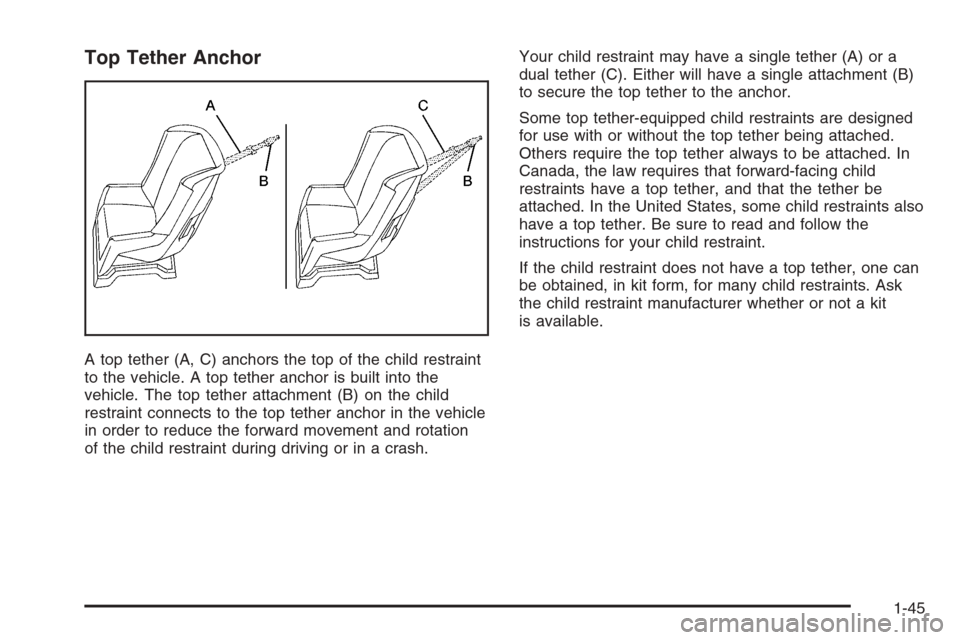
Top Tether Anchor
A top tether (A, C) anchors the top of the child restraint
to the vehicle. A top tether anchor is built into the
vehicle. The top tether attachment (B) on the child
restraint connects to the top tether anchor in the vehicle
in order to reduce the forward movement and rotation
of the child restraint during driving or in a crash.Your child restraint may have a single tether (A) or a
dual tether (C). Either will have a single attachment (B)
to secure the top tether to the anchor.
Some top tether-equipped child restraints are designed
for use with or without the top tether being attached.
Others require the top tether always to be attached. In
Canada, the law requires that forward-facing child
restraints have a top tether, and that the tether be
attached. In the United States, some child restraints also
have a top tether. Be sure to read and follow the
instructions for your child restraint.
If the child restraint does not have a top tether, one can
be obtained, in kit form, for many child restraints. Ask
the child restraint manufacturer whether or not a kit
is available.
1-45
Page 52 of 594
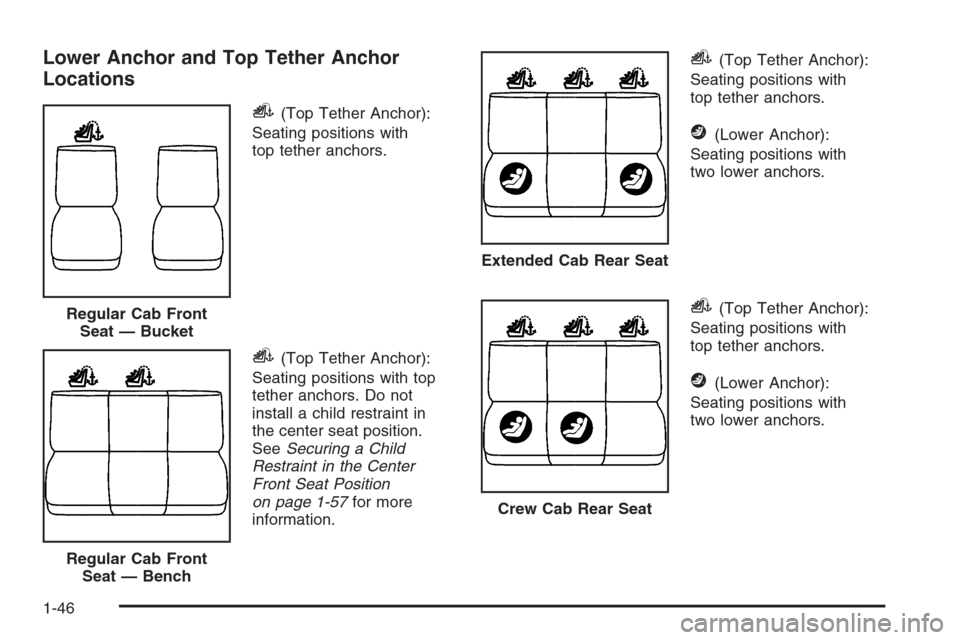
Lower Anchor and Top Tether Anchor
Locations
i(Top Tether Anchor):
Seating positions with
top tether anchors.
i(Top Tether Anchor):
Seating positions with top
tether anchors. Do not
install a child restraint in
the center seat position.
SeeSecuring a Child
Restraint in the Center
Front Seat Position
on page 1-57for more
information.
i(Top Tether Anchor):
Seating positions with
top tether anchors.
j(Lower Anchor):
Seating positions with
two lower anchors.
i(Top Tether Anchor):
Seating positions with
top tether anchors.
j(Lower Anchor):
Seating positions with
two lower anchors. Regular Cab Front
Seat — Bucket
Regular Cab Front
Seat — Bench
Extended Cab Rear Seat
Crew Cab Rear Seat
1-46
Page 53 of 594

For crew cab models, the rear passenger side and
center seating positions have exposed metal lower
anchors located in the crease between the seatback and
the seat cushion.
For extended cab models, the rear outboard seating
positions have exposed metal lower anchors located in
the crease between the seatback and the seat
cushion.
For regular and crew cab
models, there is an anchor
symbol on the trim
covers to assist you in
locating the top tether
anchors.
For regular cab models with a bench seat, the top tether
anchors are located under trim covers on the back
panel behind the center and passenger seats. Do not
install a child restraint in the center seat position.
SeeSecuring a Child Restraint in the Center Front Seat
Position on page 1-57for more information. For
regular cab models with bucket seats, the top tether
anchor is located under a trim covers on the back panel
behind the passenger seat. Remove the trim plug to
access the anchor.
Regular Cab
1-47
Page 54 of 594
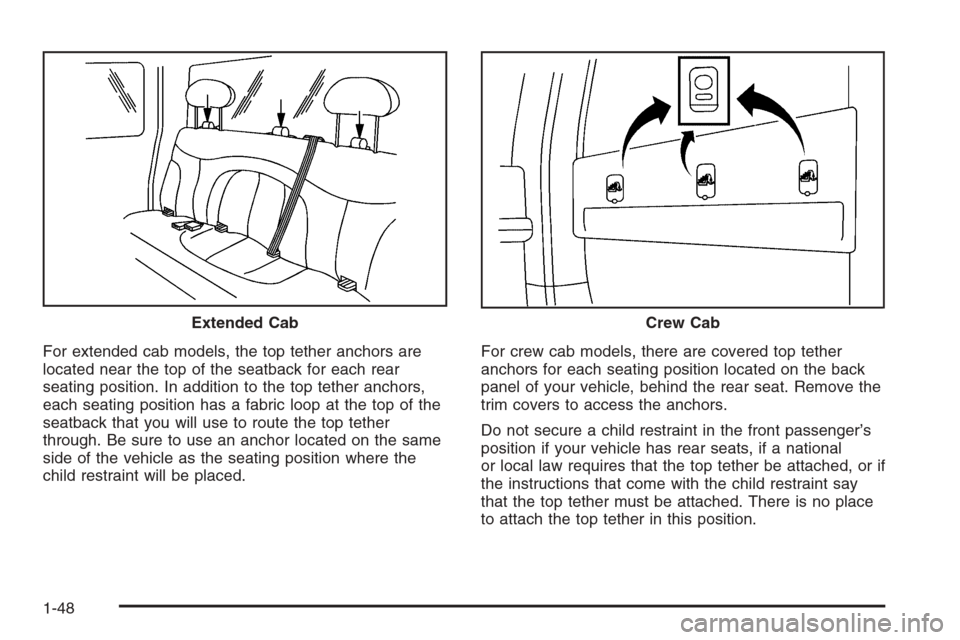
For extended cab models, the top tether anchors are
located near the top of the seatback for each rear
seating position. In addition to the top tether anchors,
each seating position has a fabric loop at the top of the
seatback that you will use to route the top tether
through. Be sure to use an anchor located on the same
side of the vehicle as the seating position where the
child restraint will be placed.For crew cab models, there are covered top tether
anchors for each seating position located on the back
panel of your vehicle, behind the rear seat. Remove the
trim covers to access the anchors.
Do not secure a child restraint in the front passenger’s
position if your vehicle has rear seats, if a national
or local law requires that the top tether be attached, or if
the instructions that come with the child restraint say
that the top tether must be attached. There is no place
to attach the top tether in this position. Extended Cab
Crew Cab
1-48
Page 55 of 594
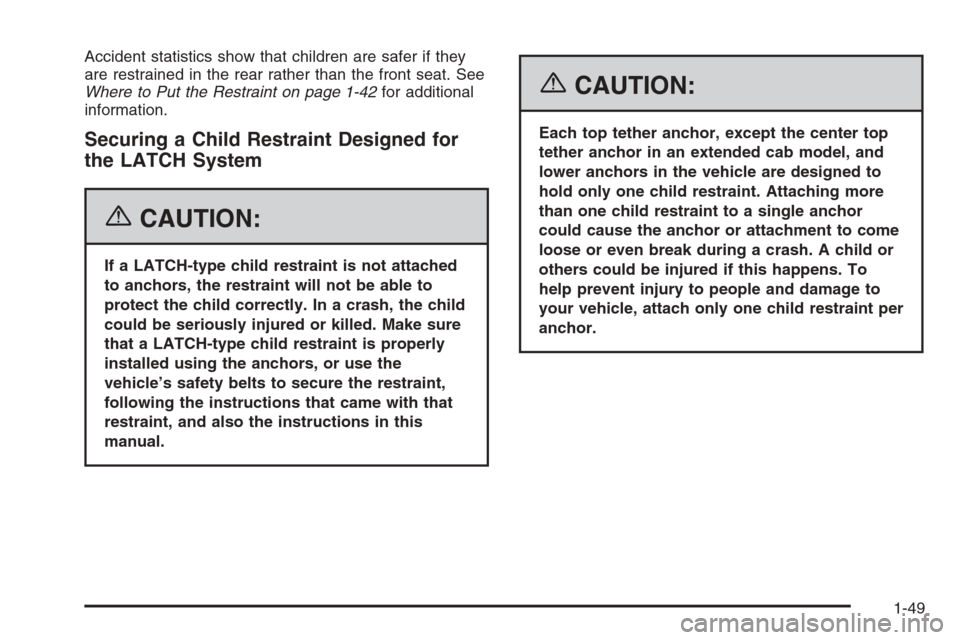
Accident statistics show that children are safer if they
are restrained in the rear rather than the front seat. See
Where to Put the Restraint on page 1-42for additional
information.
Securing a Child Restraint Designed for
the LATCH System
{CAUTION:
If a LATCH-type child restraint is not attached
to anchors, the restraint will not be able to
protect the child correctly. In a crash, the child
could be seriously injured or killed. Make sure
that a LATCH-type child restraint is properly
installed using the anchors, or use the
vehicle’s safety belts to secure the restraint,
following the instructions that came with that
restraint, and also the instructions in this
manual.
{CAUTION:
Each top tether anchor, except the center top
tether anchor in an extended cab model, and
lower anchors in the vehicle are designed to
hold only one child restraint. Attaching more
than one child restraint to a single anchor
could cause the anchor or attachment to come
loose or even break during a crash. A child or
others could be injured if this happens. To
help prevent injury to people and damage to
your vehicle, attach only one child restraint per
anchor.
1-49
Page 56 of 594
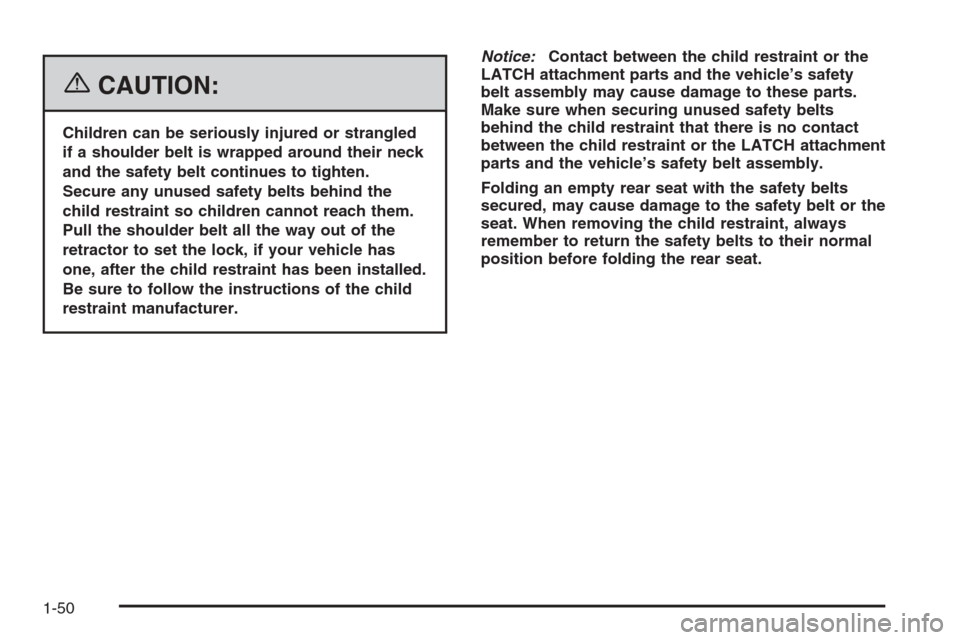
{CAUTION:
Children can be seriously injured or strangled
if a shoulder belt is wrapped around their neck
and the safety belt continues to tighten.
Secure any unused safety belts behind the
child restraint so children cannot reach them.
Pull the shoulder belt all the way out of the
retractor to set the lock, if your vehicle has
one, after the child restraint has been installed.
Be sure to follow the instructions of the child
restraint manufacturer.Notice:Contact between the child restraint or the
LATCH attachment parts and the vehicle’s safety
belt assembly may cause damage to these parts.
Make sure when securing unused safety belts
behind the child restraint that there is no contact
between the child restraint or the LATCH attachment
parts and the vehicle’s safety belt assembly.
Folding an empty rear seat with the safety belts
secured, may cause damage to the safety belt or the
seat. When removing the child restraint, always
remember to return the safety belts to their normal
position before folding the rear seat.
1-50
Page 57 of 594
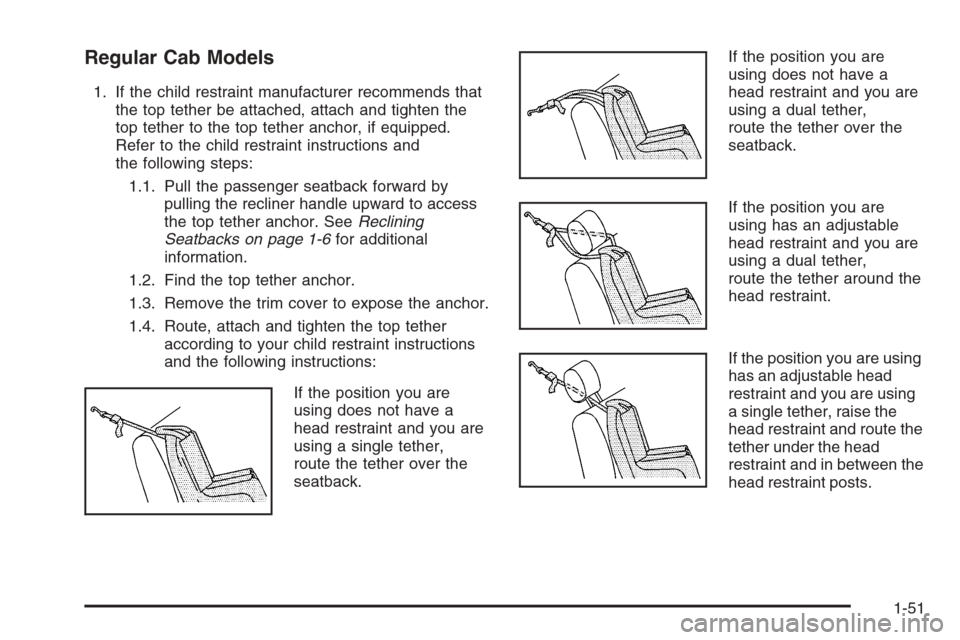
Regular Cab Models
1. If the child restraint manufacturer recommends that
the top tether be attached, attach and tighten the
top tether to the top tether anchor, if equipped.
Refer to the child restraint instructions and
the following steps:
1.1. Pull the passenger seatback forward by
pulling the recliner handle upward to access
the top tether anchor. SeeReclining
Seatbacks on page 1-6for additional
information.
1.2. Find the top tether anchor.
1.3. Remove the trim cover to expose the anchor.
1.4. Route, attach and tighten the top tether
according to your child restraint instructions
and the following instructions:
If the position you are
using does not have a
head restraint and you are
using a single tether,
route the tether over the
seatback.If the position you are
using does not have a
head restraint and you are
using a dual tether,
route the tether over the
seatback.
If the position you are
using has an adjustable
head restraint and you are
using a dual tether,
route the tether around the
head restraint.
If the position you are using
has an adjustable head
restraint and you are using
a single tether, raise the
head restraint and route the
tether under the head
restraint and in between the
head restraint posts.
1-51
Page 58 of 594
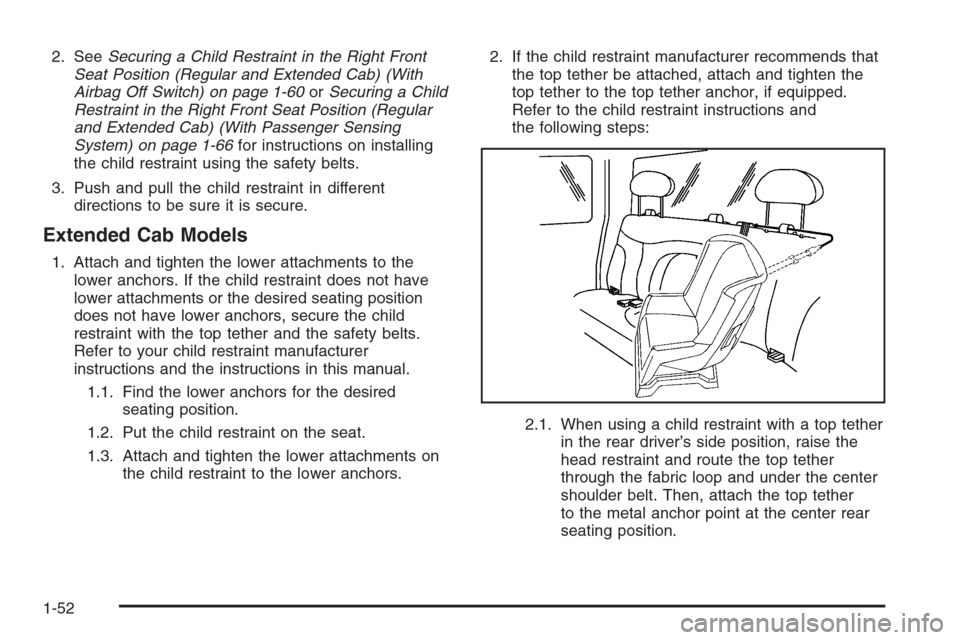
2. SeeSecuring a Child Restraint in the Right Front
Seat Position (Regular and Extended Cab) (With
Airbag Off Switch) on page 1-60orSecuring a Child
Restraint in the Right Front Seat Position (Regular
and Extended Cab) (With Passenger Sensing
System) on page 1-66for instructions on installing
the child restraint using the safety belts.
3. Push and pull the child restraint in different
directions to be sure it is secure.
Extended Cab Models
1. Attach and tighten the lower attachments to the
lower anchors. If the child restraint does not have
lower attachments or the desired seating position
does not have lower anchors, secure the child
restraint with the top tether and the safety belts.
Refer to your child restraint manufacturer
instructions and the instructions in this manual.
1.1. Find the lower anchors for the desired
seating position.
1.2. Put the child restraint on the seat.
1.3. Attach and tighten the lower attachments on
the child restraint to the lower anchors.2. If the child restraint manufacturer recommends that
the top tether be attached, attach and tighten the
top tether to the top tether anchor, if equipped.
Refer to the child restraint instructions and
the following steps:
2.1. When using a child restraint with a top tether
in the rear driver’s side position, raise the
head restraint and route the top tether
through the fabric loop and under the center
shoulder belt. Then, attach the top tether
to the metal anchor point at the center rear
seating position.
1-52
Page 59 of 594
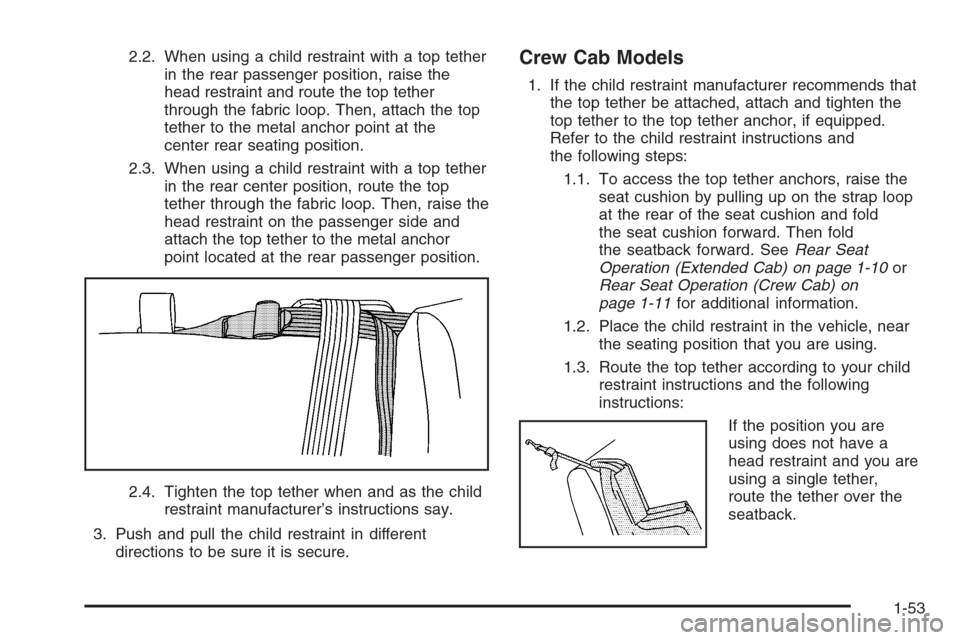
2.2. When using a child restraint with a top tether
in the rear passenger position, raise the
head restraint and route the top tether
through the fabric loop. Then, attach the top
tether to the metal anchor point at the
center rear seating position.
2.3. When using a child restraint with a top tether
in the rear center position, route the top
tether through the fabric loop. Then, raise the
head restraint on the passenger side and
attach the top tether to the metal anchor
point located at the rear passenger position.
2.4. Tighten the top tether when and as the child
restraint manufacturer’s instructions say.
3. Push and pull the child restraint in different
directions to be sure it is secure.Crew Cab Models
1. If the child restraint manufacturer recommends that
the top tether be attached, attach and tighten the
top tether to the top tether anchor, if equipped.
Refer to the child restraint instructions and
the following steps:
1.1. To access the top tether anchors, raise the
seat cushion by pulling up on the strap loop
at the rear of the seat cushion and fold
the seat cushion forward. Then fold
the seatback forward. SeeRear Seat
Operation (Extended Cab) on page 1-10or
Rear Seat Operation (Crew Cab) on
page 1-11for additional information.
1.2. Place the child restraint in the vehicle, near
the seating position that you are using.
1.3. Route the top tether according to your child
restraint instructions and the following
instructions:
If the position you are
using does not have a
head restraint and you are
using a single tether,
route the tether over the
seatback.
1-53
Page 60 of 594
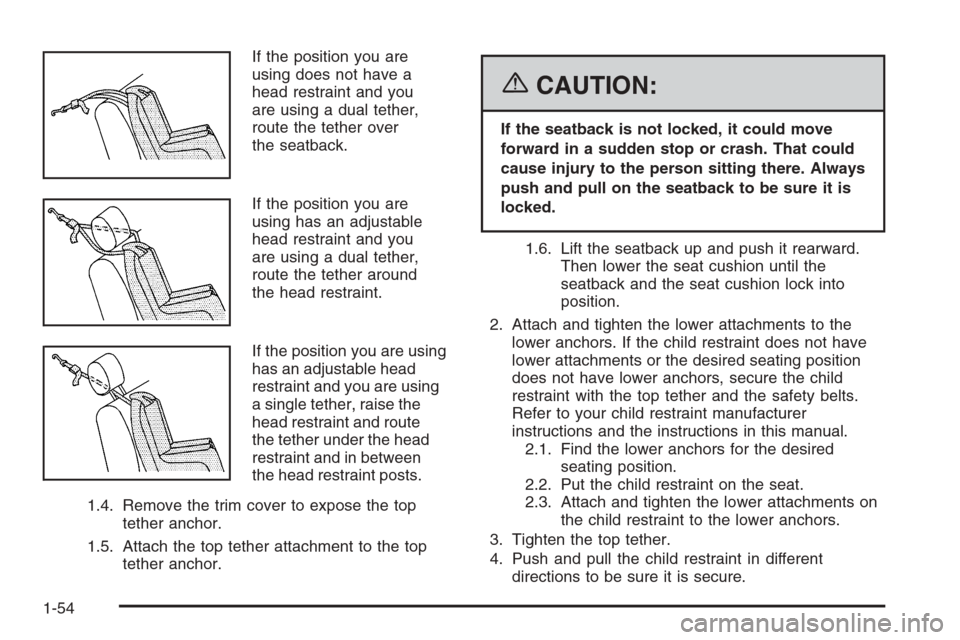
If the position you are
using does not have a
head restraint and you
are using a dual tether,
route the tether over
the seatback.
If the position you are
using has an adjustable
head restraint and you
are using a dual tether,
route the tether around
the head restraint.
If the position you are using
has an adjustable head
restraint and you are using
a single tether, raise the
head restraint and route
the tether under the head
restraint and in between
the head restraint posts.
1.4. Remove the trim cover to expose the top
tether anchor.
1.5. Attach the top tether attachment to the top
tether anchor.
{CAUTION:
If the seatback is not locked, it could move
forward in a sudden stop or crash. That could
cause injury to the person sitting there. Always
push and pull on the seatback to be sure it is
locked.
1.6. Lift the seatback up and push it rearward.
Then lower the seat cushion until the
seatback and the seat cushion lock into
position.
2. Attach and tighten the lower attachments to the
lower anchors. If the child restraint does not have
lower attachments or the desired seating position
does not have lower anchors, secure the child
restraint with the top tether and the safety belts.
Refer to your child restraint manufacturer
instructions and the instructions in this manual.
2.1. Find the lower anchors for the desired
seating position.
2.2. Put the child restraint on the seat.
2.3. Attach and tighten the lower attachments on
the child restraint to the lower anchors.
3. Tighten the top tether.
4. Push and pull the child restraint in different
directions to be sure it is secure.
1-54